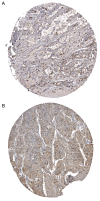Identification of differentially expressed protein-coding genes in lung adenocarcinomas
- PMID: 32010276
- PMCID: PMC6966171
- DOI: 10.3892/etm.2019.8300
Identification of differentially expressed protein-coding genes in lung adenocarcinomas
Abstract
Lung adenocarcinoma accounts for a high proportion of lung cancers. Though efforts have been made to develop new and effective treatments for this disease, the mortality rate remains high. Gene expression microarrays facilitate the study of lung cancer at the molecular level. The present study aimed to detect differentially expressed protein-coding genes to identify novel biomarkers and therapeutic targets for lung adenocarcinoma. Aberrations in gene expression in lung adenocarcinoma were determined by analysis of mRNA microarray datasets from the Gene Expression Omnibus database. Gene Ontology (GO) and Kyoto Encyclopedia of Genes and Genomes (KEGG) pathway analysis, protein-protein interaction (PPI) networks and statistical analysis were used to identify the biological functions of the differentially expressed genes (DEGs). The results of the bioinformatics analysis were subsequently validated using reverse transcription-quantitative PCR. A total of 303 DEGs were identified in lung adenocarcinomas, and they were enriched in a number of cancer-associated GO terms and KEGG pathways. DNA topoisomerase 2α (TOP2A), cell division cycle protein homolog 20 (CDC20), mitotic checkpoint serine/threonine protein kinase BUB1 (BUB1) and mitotic spindle assembly checkpoint protein MAD2A (MAD2L1) exhibited the highest degree of interaction in the PPI network. Survival analysis performed using Kaplan-Meier curves and Cox regression indicated that these four genes were all significantly associated with the survival of patients with lung adenocarcinomas. In conclusion, TOP2A, CDC20, BUB1 and MAD2L1 may be key protein-coding genes that may serve as biomarkers and therapeutic targets in lung adenocarcinomas.
Keywords: DNA topoisomerase 2α; bioinformatics analysis; biomarkers; cell division cycle protein homolog 20; lung adenocarcinoma; mitotic checkpoint serine/threonine protein kinase BUB1; mitotic spindle assembly checkpoint protein MAD2L1.
Copyright © 2020, Spandidos Publications.
Figures








Similar articles
-
Identification of key protein-coding genes in lung adenocarcinomas based on bioinformatic analysis.Transl Cancer Res. 2019 Dec;8(8):2829-2840. doi: 10.21037/tcr.2019.10.45. Transl Cancer Res. 2019. PMID: 35117040 Free PMC article.
-
Identification of key biomarkers and potential molecular mechanisms in lung cancer by bioinformatics analysis.Oncol Lett. 2019 Nov;18(5):4429-4440. doi: 10.3892/ol.2019.10796. Epub 2019 Sep 4. Oncol Lett. 2019. PMID: 31611952 Free PMC article.
-
Bioinformatics study on genes related to a high-risk postoperative recurrence of lung adenocarcinoma.Sci Prog. 2021 Jul-Sep;104(3):368504211018053. doi: 10.1177/00368504211018053. Sci Prog. 2021. PMID: 34304612 Free PMC article.
-
Screening key genes and signaling pathways in colorectal cancer by integrated bioinformatics analysis.Mol Med Rep. 2019 Aug;20(2):1259-1269. doi: 10.3892/mmr.2019.10336. Epub 2019 Jun 4. Mol Med Rep. 2019. PMID: 31173250 Free PMC article.
-
Upregulation of ASPM, BUB1B and SPDL1 in tumor tissues predicts poor survival in patients with pancreatic ductal adenocarcinoma.Oncol Lett. 2020 Apr;19(4):3307-3315. doi: 10.3892/ol.2020.11414. Epub 2020 Feb 19. Oncol Lett. 2020. PMID: 32218868 Free PMC article.
Cited by
-
Origin recognition complex subunit 1 (ORC1) augments malignant behaviors of lung adenocarcinoma cells via targeting Wnt signaling.Bioengineered. 2022 May;13(5):13520-13533. doi: 10.1080/21655979.2022.2078562. Bioengineered. 2022. PMID: 36700467 Free PMC article.
-
Rheumatoid arthritis-recent advances in pathogenesis and the anti-inflammatory effect of plant-derived COX inhibitors.Naunyn Schmiedebergs Arch Pharmacol. 2024 Aug;397(8):5363-5385. doi: 10.1007/s00210-024-02982-3. Epub 2024 Feb 15. Naunyn Schmiedebergs Arch Pharmacol. 2024. PMID: 38358467 Review.
-
Bioinformatics analysis of BUB1 expression and gene regulation network in lung adenocarcinoma.Transl Cancer Res. 2020 Aug;9(8):4820-4833. doi: 10.21037/tcr-20-1045. Transl Cancer Res. 2020. PMID: 35117845 Free PMC article.
-
Identification of potential core genes in lung cancer and therapeutic traditional Chinese medicine compounds using bioinformatics analysis.Medicine (Baltimore). 2024 Sep 27;103(39):e39862. doi: 10.1097/MD.0000000000039862. Medicine (Baltimore). 2024. PMID: 39331864 Free PMC article.
-
AURKA, TOP2A and MELK are the key genes identified by WGCNA for the pathogenesis of lung adenocarcinoma.Oncol Lett. 2023 Apr 19;25(6):238. doi: 10.3892/ol.2023.13824. eCollection 2023 Jun. Oncol Lett. 2023. PMID: 37153047 Free PMC article.
References
-
- Centers for Disease Control and Prevention. cdc.gov/cancer/lung/statistics/index.htm. [Mar 26;2014 ];Lung Cancer Statistics.
LinkOut - more resources
Full Text Sources
Miscellaneous
